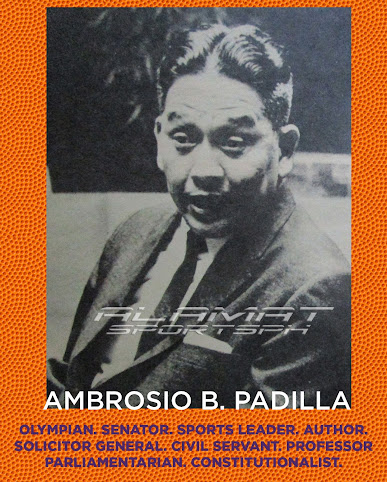In the annals of Philippine basketball history, one name stands out for achieving his ambitions in two supposedly diametrically opposed fields: Sports and Academics. In both disciplines, AMBROSIO B. PADILLA left his exemplary mark of excellence—as captain of the Philippine Basketball Team, he gave the country its best-ever finish in the 1936 Olympiad in Berlin, placing 5th among the world’s best basketeers—an incredible feat that has yet to be duplicated. In the same breath, Padilla was a brilliant student of Ateneo , graduating summa cum laude, and then finishing law at the state university as Class Salutatorian.
Born in Lingayen, Pangasinan on 7 Dec 1910 to Dr. Nicanor Padilla and Ysabel Bibby, “Paddy” as he was called, grew up with 11 siblings. His formative high school and college years were spent at the Ateneo de Manila, where he developed a love for basketball. As a varsity player, he skippered the Blue Eagles that won the 1928 NCAA basketball championship.
At age 20, Padilla made it to the 1930 national cage team that went to Tokyo, Japan for the Far East Games, winning Gold after beating the host country. His team mates included Augusto Bautista (who won his 5th basketball medal, plus medals in volleyball), Alfredo del Rosario, Pedro Villanueva, Mariano Filomeno, Rizalino Gamban, Johnny Schlobohm, Briccio Reynoso, Jesus Lacson Suarez and Jacinto Ciria Cruz. The formidable Filipinos repeated their triumph before a thrilled Manila home crowd in 1934, in what would be the last Far East Games. That same year, he earned his Law degree as Salutatorian from the University of the Philippines, and became a bar topnotcher by placing 3rd in the exams.
The
highlight of his sporting career was to come 2 years later. Though Padilla
– now a full-fledged lawyer--had earned a reputation as a skilled basketball
player, he still had to pass the tryouts to secure a spot on the Olympic
team for Berlin. There was no dearth of talents in the country with
the most developed basketball sports program in Asia, thanks to the Americans. Padilla
passed the tryouts with flying colors, and was named a member of the elite 1936
Philippine Basketball team.
The Philippines had a great start, winning two in a row by beating Mexico and Estonia. But then, to shorten the tournament, a new ruling was announced that any loss thereafter would put a team in the consolation bracket.
In the
quarterfinal, the Filipinos were pitted against the much taller United
States players--and lost 56-23. Thus
ended their Olympic journey, though it was their one and only defeat.
Like true sportsmen, the team continued on in the classification rounds,
winning over Italy, and then Uruguay, landing the Philippines
in 5th place among 21 countries with a 4-1 record. The U.S.
won 1st, Brazil in 2nd, and Mexico—which the Philippines
had defeated in the early rounds, placed 3rd. Still, this was Asia’s
best finish ever in the Olympic Games men’s basketball history.
The Olympians returned to a tumultuous welcome for their unprecedented feat, and when the Olympic hoopla died down, Padilla move on and went back to school at the University of Santo Tomas, earning his doctorate in Civil Law in 1938 with honors. Though officially retired from basketball, he worked tirelessly for the upliftment of the sport, serving as chairman of the Philippine Amateur Athletic Federation (PAAF) Basketball Committee from 1938 to 1954.
In 1941, he married Lourdes “Lily” de las Alas (b. 18 Oct. 1917/d. 29 Jul. 1994) daughter of former finance secretary Antonio de las Alas under the Quezon administration. They became parents of 10 children: Josie, Vicente, Francisco, Ambrosio Jr, Lourdes, Felipe, Manny, Alexander, Gigi, and Rose.
In 1954, Padilla forayed into politics after his
appointment as Solicitor General by Pres. Ramon Magsaysay. He was
elected Senator in 1957, serving 3 terms until 1969, which was
interrupted by Martial Law. After Marcos’s ouster, Pres.
Corazon Aquino appointed him to the 1986 Constitutional Commission,
which he served as Vice Chair.
His association with basketball continued with his FIBA appointment as Vice President for Asia (1956-1964). He was also elected President of the Asian Basketball Confederation (ABC, now FIBA-Asia). Padilla also had the distinction of being the 1st president of the Philippine Olympic Committee (formerly PAAF) in 1975.
The acclaimed Olympian and Senator, who
served and honored the country in two different fields passed away on 11 Aug.
1996 at the Capitol Medical Center, and laid to rest in his
beautiful retreat, Alpadi’s Farm in Antipolo. He was inducted
post-humously into the Philippine National Basketball Hall of Fame in
January 1999, along with his own Olympic coach, Chito Calvo.
In his honor, an award for top academically-gifted Ateneo student athletes, and a room at the Malcom Hall of the U.P. College of Law, bear his name. In 2010, a stamp was also struck to mark his birth centenary. Today, Ambrosio Padilla is regarded as one of the most important sports figures to shape the course of basketball development in Asia.
SOURCES:
Christian Bocobo and Beth
Celis, Legends and Heroes of Philippine Basketball, ©2004 by Christian Bocobo,
p. 114
Senator’s profile,
Ambrosio Padilla: https://legacy.senate.gov.ph/senators/former_senators/ambrosio_padilla.htm
Ambrosio Padilla, https://en.wikipedia.org/wiki/Ambrosio_Padilla
Bill Velasco, The Game of
My Life column, “Unresolved Olympic Controversies”, 13 Feb. 2021, The Philippine
Star
David Wallechinsky, The
Complete Book of the Olympics, ©1988, Viking Penguin, “Basketball”, p. 173
“Basketball Olympian,
Senator Dead at 85”, Manila Standard, 26 Aug. 1996 issue, p.4














No comments:
Post a Comment